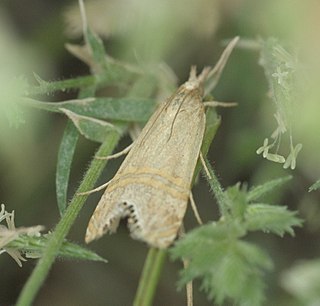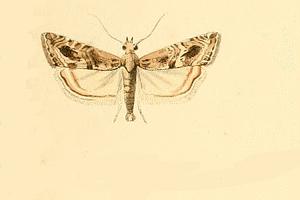
Crambidae comprises the grass moth family of lepidopterans. They are variable in appearance, with the nominal subfamily Crambinae taking up closely folded postures on grass stems where they are inconspicuous, while other subfamilies include brightly coloured and patterned insects that rest in wing-spread attitudes.

Scoparia ambigualis is a species of moth of the family Crambidae described by Friedrich Treitschke in 1829. It is found in Europe and Asia Minor and possibly in Guangdong and Shanxi in China.

Euchromius is a genus of moths of the family Crambidae. It was described by Achille Guenée in 1845.

Gillmeria pallidactyla is a moth of the family Pterophoridae first described by the English entomologist, Adrian Hardy Haworth in 1811. It has a Holarctic distribution and is widespread throughout North America and the Palearctic.

Euchromius cambridgei is a species of moth in the family Crambidae described by Philipp Christoph Zeller in 1867. It is found in France, Spain, Portugal, Italy, Croatia, Ukraine, the Canary Islands, Tunisia, Libya, Egypt, Sudan, Israel, Jordan, Saudi Arabia, Iran, Afghanistan and Pakistan.
Euchromius zephyrus is a species of moth in the family Crambidae. It is found in Senegal, Mali, Côte d'Ivoire, Ghana and Nigeria.
Euchromius klimeschi is a species of moth in the family Crambidae. It is found in Ethiopia, Somalia, Kenya, Tanzania, Zaire, Zambia, Zimbabwe, Madagascar, Mozambique, South Africa and Namibia.
Euchromius discopis is a species of moth in the family Crambidae. It is found in Zimbabwe, Botswana, South Africa and Namibia. The habitat consists of steppe, dry woodland areas and macchia vegetations up to an altitude of 2,000 meters.
Euchromius labellum is a species of moth in the family Crambidae. It is found in Kenya.
Euchromius nigrobasalis is a species of moth in the family Crambidae. It is found in Zimbabwe and South Africa.
Euchromius aris is a species of moth in the family Crambidae. It is found in Kenya.
Euchromius hampsoni is a species of moth in the family Crambidae. It is found in Niger.
Euchromius geminus is a species of moth in the family Crambidae. It is found in Kenya.
Euchromius tanalis is a species of moth in the family Crambidae. It is found in the mountainous areas of Kenya and Ethiopia. The habitat consists of montane vegetation zones at altitudes ranging from about 1,200 to 3,250 meters.
Euchromius mythus is a species of moth in the family Crambidae. It occurs in most of eastern and southern Africa, including Kenya, Tanzania, Zaire, Malawi, the Comoros, Madagascar, Zimbabwe, Namibia and South Africa. The habitat consists of moist and dry savanna and woodland areas, up to an altitude of 1,000 meters.
Euchromius matador is a species of moth in the family Crambidae. It is found in eastern Zaire and western Tanzania. The habitat consists of moist woodland, savanna areas and montane areas.
Euchromius gnathosellus is a species of moth in the family Crambidae. It is found from west to central Africa, including Senegal, Sierra Leone, Ivory Coast, Ghana, Togo, Nigeria and the Central African Republic. The habitat consists mainly of plantation areas mixed with pockets of secondary forest.

Euchromius vinculellus is a species of moth in the family Crambidae. It is found from France, Spain, Portugal, Italy, Greece and Morocco east to Saudi Arabia, Oman and Afghanistan. It is also found in Niger and Kenya.
Scoparia brevituba is a moth in the family Crambidae. It was described by Wei-Chun Li, Hou-Hun Li and Matthias Nuss in 2010. It is found in Sichuan, China.

Udea turmalis is a moth in the family Crambidae. It was described by Augustus Radcliffe Grote in 1881. It is found in North America, where it has been recorded from Alberta, Arizona, British Columbia, California, Colorado, Idaho, Manitoba, Montana, Nevada, New Mexico, Utah and Washington.






